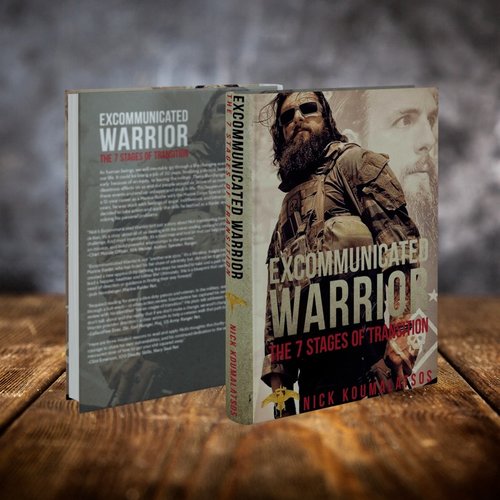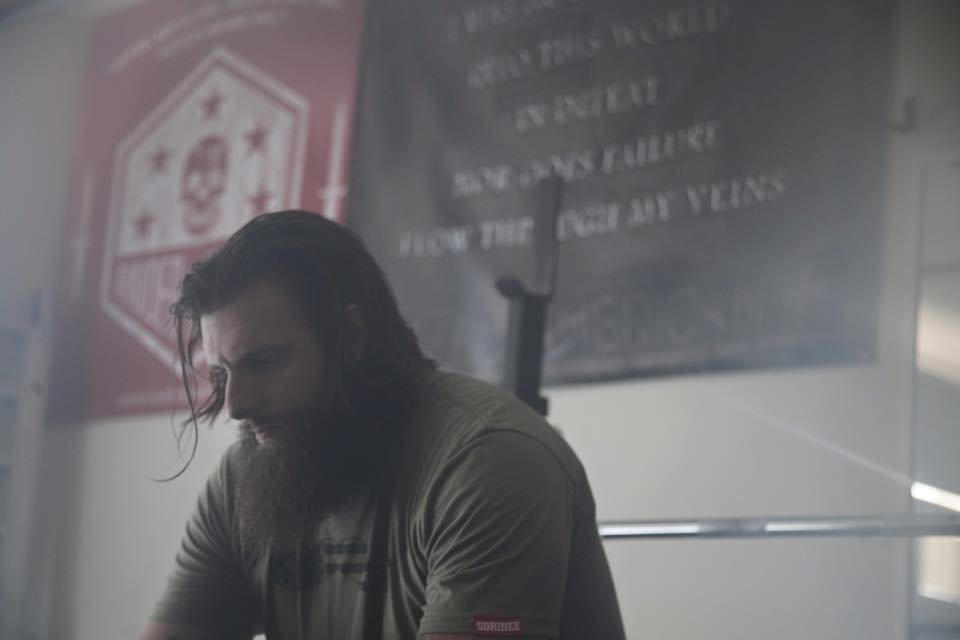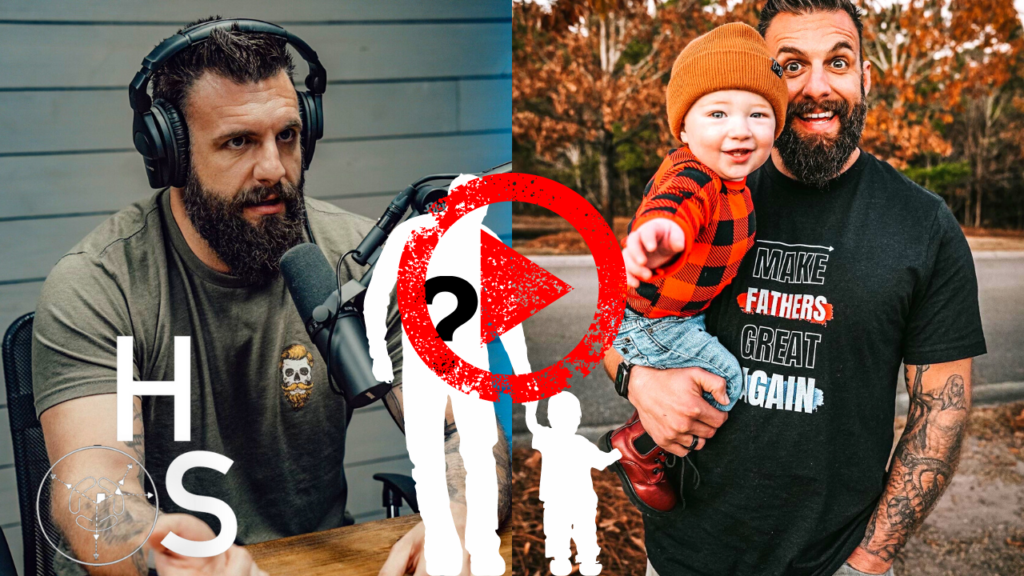Long Term Conflict in Afghanistan

In the beginning of the Afghanistan conflict, the US utilized CIA and Special Forces (SF) to make contact with some of their cold war contacts in order to oust the Taliban. They established local security militias to secure and govern their own villages. This process was working and the Taliban’s strength was collapsing. Soon after this, the coalition forces came to Afghanistan in force and took over as the overall arching theater command. For several years coalition forces directly targeted known Taliban. Eight years later we find ourselves executing the same program the CIA and SF were utilizing in the beginning (1). So, how would the outcome of the post 2001 September 11th conflict in Afghanistan be different if we had continued with Asymmetrical operations versus conventional military methodology?
To understand my research question we first have to understand Afghanistan and all the variables that come in to play. The first independent variable is the missing link between the tribal village and the government of Afghanistan. Afghanistan has always been a country with a tribal social system but within the last 100 years the new world has forced them to develop a government that mimics a democratic one. Leaving a gap between what Afghans recognize at the village level and where the Afghan government begins. By working with the local villages and establishing local security and linking them to the local government we bridge a gap between the two.
The second variable would be the lack of education in the country. The majority of Afghans do not even make it to elementary grade level schooling. Individuals who can read and write are few and far between. Without education, individuals will continue to believe what their families before them taught and not evolve with the changing world.
Third would be the amount of poverty and unemployment within the country. Afghans focus on surviving and making it through each day. Unemployment is at 35% and many of those are young males (4). By utilizing this methodology and creating local security we create jobs as well as the ability for outsiders to travel in and out bringing goods and work.
IV + IV + IV = DV
Connection to Government + Uneducated + Poverty= Instability
My hypothesis is if we could have continued this line of methodology earlier on in the Afghanistan conflict then we would have come to the same result that we are at now, only sooner (8).
Afghanistan has always been a volatile place due to its location, linking China and India to Europe. It has been part of many empires: Persian, Greek, Russian, and British. In 651 BC, Mohammad Ali created Islam and Afghanistan became an Islamic state. Due to its history, Afghanistan has always stayed a tribal nation (11). In the 1880’s, King Abdur Rahman Khan forcibly migrated one of the tribes from the south and spread them out around Afghanistan. He did this due to their unruliness; he wanted to break down the tribal structure and build a more modern state. This formed what we now know as the “Pashtun belt” (12). This brought us into the 20th century where Afghanistan seems to go though many stages very quickly. This instability brought us to the Soviet invasion and eventually the Mujahedeen and Taliban era.
The U.S. got involved with Afghanistan during the 80’s due to the Cold War. The Soviet Union wanted to gain ground and control Afghanistan due to its proximity with other countries, warm water and the Persian Gulf. The U.S. saw this as a threat and began working with individuals that had formed the Northern Alliance against the invading Soviet Union. The CIA trained and equipped the Northern Alliance to effectively combat the Soviet Union. It was not until the CIA equipped them with stinger missiles that the Soviets knew that they had beaten. Eventually a cease-fire was called and the soviets withdrew from Afghanistan (6). Now, with the majority of Afghanistan as our allies, this would have been a perfect time to capitalize on their victory and to secure Afghanistan as a pro U.S. country. Instead we withdrew and left them to their own devices.
With no U.S. presence in Afghanistan, it immediately became an unstable country that was susceptible to radical Islamic views. It also left tribes fighting about who should be in power of the country. All of the refugees that had been ousted to Pakistan returned to their country to establish some sort of order. This, of course, continued to fail. Tribal leaders were based in Pakistan and maintained a strong- arm presence in Afghanistan. Afghanistan would stay divided due to the tribal differences and their strong connection to individuals outside of Afghanistan (11). These factors made Afghanistan a ripe environment for the Taliban to be created.
The Pakistanis set their eyes upon the goal of a peaceful Afghanistan in the hopes of building an oil and gas pipeline from Turkmenistan to Pakistan through Afghanistan. There was a religious organization known as the Jamaia-i- Ulama-i-Islam (JUI) that had become a partner with the Pakistan government. This religious organization was the Taliban. They began to train, arm, finance, and equip the Taliban. Even America and Saudi supported this idea due to the possible positive financial outcome. Within a few months, the Taliban had control of a majority of the country, with the exception of the Northern Alliance, which was made up of Uzbek, Hazara and Tajik Tribes. The JUI and Taliban are predominately Pashtuns (9). Once the Taliban had the majority of control it was an easy fit for Osama Bin Laden to establish training camps within the borders to begin planning and training Al-Qaeda.
This brings us to our current conflict and how we got to where we are. The United States Government understood that Afghanistan was a complicated place. The President and Secretary of Defense knew that Afghanistan was not a place for a conventional war. “They recognized two critical shortcomings. No plan existed to fight a conventional war in Afghanistan, nor did the U.S. maintain basing arrangements with any neighboring countries from which ground forces could rapidly enter Afghanistan. Geographically constrained by a mountainous topography, U.S. forces would either have to fly, or to move overland into Afghanistan. Only the CIA could respond with the speed desired by the President, making impossible the deployment of large conventional units into theater” (1). Not to mention that the Taliban was formed in small militias and any invading conventional forces would force them into the mountains, which would result in a light infantry fight. This was a key struggle to come up with a course of action and strategy for Afghanistan. The U.S. decided to infiltrate Afghanistan utilizing the Cold War contacts with the northern alliance to topple the Taliban regime. The US government utilized Special Operation Forces (SOF), Central Intelligence Agency (CIA) and support assets to accomplish their objectives in Afghanistan, which were to oust the Taliban and Al-Qaeda (1). These were thoughts of the political government, DOD and CIA on how they will tackle Afghanistan; it is known upfront that Afghanistan is not a place for a conventional war (6). Which, in hindsight, this thought seems to change in our government’s mind. The Special Operations community had been focused on FID and UW after the Gulf War. After many years of SOF conducting operations in areas like Kosovo and Bosnia, they started to rebuild their credibility with the policy side of US Government. Senior military leaders knew that Afghanistan’s fight would not be conventional and these successes lead to the confident decision to utilize SOF and CIA solely in the invasion of Afghanistan.
The five core missions of SOF are Special Reconnaissance (SR), Direct Action (DA), Foreign Internal Defense (FID), Unconventional Warfare (UW) and Combating Terrorism (CT) (13). They each have different perceptions of when they should be applied. This is important to know so we can understand the thought process behind the invasion of Afghanistan. The U.S. and Secretary of defense decided to use a combination of all this skills simultaneously to quickly accomplish their objective.
By 26 September, 2001 the CIA and SOF had already infiltrated Afghanistan in order to link up with the CIA’s Northern Alliance Contacts, which we can only assume are from the Cold War era. They utilized a balance of SOF and CIA linking up with anti-Taliban groups and establishing trained militias to oust the Taliban. Soon after this was established, there was a Seal Team task force put together to conduct DA Raids on known Taliban utilizing Close Air Support (CAS) (14). Within a few months, the Taliban had completely lost all control of the country and was on the run. But, due to a low number of operators on the ground, there were a lot of Taliban that escaped the country.
Success, right? The Taliban start taking an asymmetrical approach and not fighting the US head on (3). I wonder if this was the start of when conventional military wisdom took over from what the CIA and SOF was accomplishing. This is when asymmetrical warfare in its relation to law of armed conflict and the Geneva Convention becomes complicated. From personal experience this one hits close to home; it is something that operators and military professionals need to know and understand. When conducting these operations, we have to abide by these rules even if the opposition is not. These rules even govern our dress and our conduct of combat operations. When working with surrogate forces and conducting asymmetrical operations, the lines can very easily get blurred; it is good to have a solid understanding of armed conflict and its relation to an asymmetrical operation (3).
The Taliban was officially not in control of the country by December 2001. At this exact time, the UN Security Council created the International Security Assistance Force (ISAF), who would have operational control over Operation Enduring Freedom Afghanistan. By 2003, NATO had taken over control of ISAF from the US (15). Because of this, around the beginning of 2003 we see a change in tactics as well as the Taliban. In 2003, the Taliban organize an active insurgency.16 We see an up kick in American casualties from 45 deaths in 2003 to 98 in 2004 once NATO has control of ISAF. Then, in 2009 until 2012 we see an enormous increase in casualties. Why?
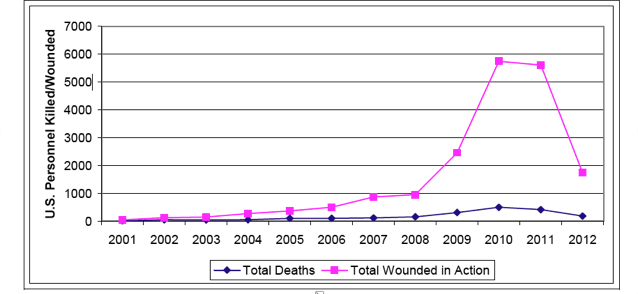
Figure I. American Casualties by Year Through July 12, 2012 (Chesser 2012)
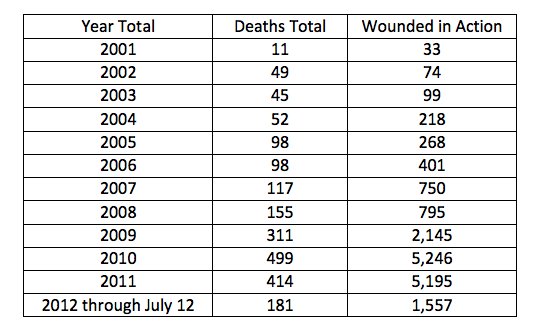
Figure II. American Casualties by year Through July 12, 2012 (Chesser 2012)
With Iraq winding down in late 2007, there seemed to be an immediate plan for a troop surge in Afghanistan (16). With more troops comes more support requirements, which means the US has to spend more money. The figures speak for themselves (18).
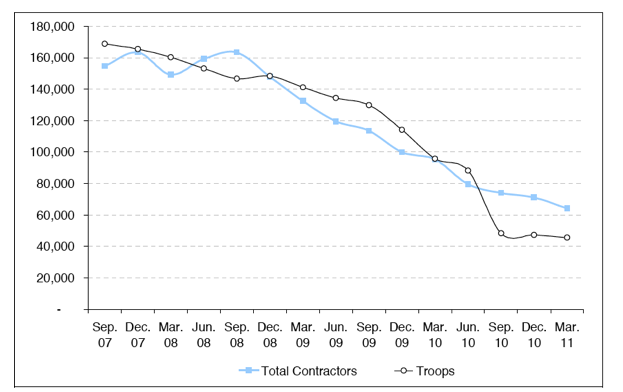
Figure III Number of Contractor Personnel in Iraq vs. Trop Levels (Schwartz 2011)
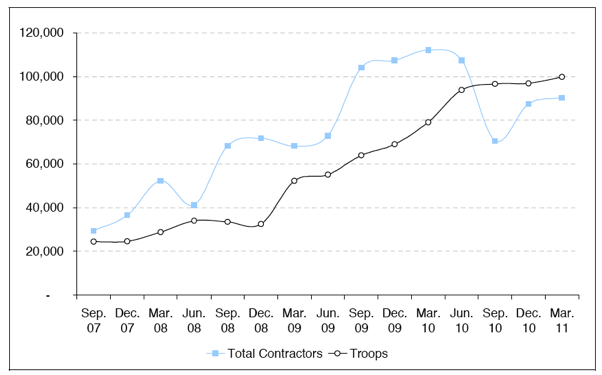
Figure IV Number of Contractor Personnel In Afghanistan vs. Troop Levels (Schwartz 2011)
So with more troops comes more money, with more money comes more casualties. It seems we exchanged one problem for another to keep support and defense contracts alive.18
With casualties higher than they have ever been in 10 years, policy makers were forced to make a change in ISAFs’ strategic goals. In late 2009 they started to look at Civil Defense Initiative (CDI), which quickly became the Local Defense Initiative (LDI) and finally Village Stability Operation (VSO) (5). This term was created when Dr. Seth G. Jones a senior Political Scientist started working with Major General Flynn on how to stabilize Afghanistan. Dr. Jones helped Gen. Flynn see that there was a gap between the villages of Afghanistan and its government.
The four steps that Dr. Jones came up with was Shape, Build, Hold and Transition. The idea was that a Special Operations Team would begin negotiations with village elders to persuade them towards establishing their own security with guidance and support from the team. The shaping part would be the negotiations, and eventually being invited in to leave with the village while simultaneously utilized direct action personnel try to remove any hard lying individuals that did not want to transition from Taliban to Afghan Local Police. Once the team is invited in, they would begin training and equipping local villagers to stand security in their own village – this would be the build part. Once security had been established a myriad of programs would begin. The team would be able to bring in contractors for reconstruction of their villages, they would have the ability to bring educators from around the country to teach the security force and their families how to read and write – this is all during the hold phase (19, 20).
Now the transition piece seems to be a little bit trickier. The idea is that the Afghan Local Police (ALP) would transition over to some branch of the Afghan Government, either the Afghan National Police (ANP) or the Afghan Border Patrol (ABP). But, due to the massive amount of corruption in the Afghan Government from the Presidential Staff down to the lowest levels of government this seems to rest solely on the Special Operations Team to keep the Village linked to the District Government. As you can see from the statics above the program does work we have seen an enormous drop in capsulitis since the ISAF stopped playing whack a mole with Taliban Insurgents and put the problem of security on the Afghan People. 19, 20
How would have the post 2001 September 11th conflict in Afghanistan outcome been different if we had continued with Asymmetrical operations verses conventional military methodology?
From what I gather, it’s just not that simple. There seems to have been many decisions that were made to get us to the present point we are at now. The overall solution for a possible successful course of action in Afghanistan is a blend of these strategies: to develop a grass roots initiative of local security forces, hereby linking to Afghanistan’s district government and conducting direct action raids for the individuals that will not reconcile with the Afghanistan government. Meanwhile the Department of State works with the government of Afghanistan on their foreign policy. But what was our goal in Afghanistan? To remove the Taliban from power and establish an Islamic democratic society so that Afghanistan would not be a breeding ground for terrorists. My question remains, while all this seems that it could possibly work to the benefit of the US as well as Afghanistan, will it work when the coalition forces do not have a sustained presence in Afghanistan?
Reference
1. Martino, Lucio. “From Covert through Overt to Covert again: The Parabola of U.S. Special Operation Forces.” CEMISS QUARTERLY 3 (2005), http://scholar.googleusercontent.com/scholar?q=cache:W3ExqzJlCqIJ:scholar.google.com/ Lucio Martino from covert to overt&hl=en&as_sdt=0,34 (accessed July 15, 2012).
2. “Predator Morality.” Wall Street Journal, Feb 20, 2002, http://search.proquest.com/docview/398973643?accountid=8289 (accessed June 17, 2012).
3. Paulus, Andreas and Mindia Vashakmadze. “Asymmetrical War and the Notion of Armed Conflict – a Tentative Conceptualization.” International Review of the Red Cross 91, no. 873 (2009): 95-125, http://search.proquest.com/docview/217741428?accountid=8289 (accessed June 17, 2012).
4. Central Intelligence Agency, “CIA World Fact Book.” Last modified June 20, 2012. Accessed June 24, 2012. https://www.cia.gov/library/publications/the-world-factbook/geos/af.html.
5. Ty Cornet and Cassidy Bob. “VSO: More than a Village Defense.” Special Warfare 24 (2011): 22-27.
6. Kagen, Fredrick, Kimberly Kagen, Jeffery Dressler, and Carl forstberg. Success in Afghanistan. Washington, DC: American public enterprise Institute for public policy research, Institute for the study of war, 2011. http://www.ciaonet.org.ezproxy1.apus.edu/wps/aei/0023100/ (accessed July 1, 2012).
7. Clauser, Jerome and Jan Goldman. 2010. Introduction to Intelligence Research and Analysis. Lanham, MD: Scarecrow Press.
8. DeVault, Gigi. Choosing Between Qualitative and Quantitative Methods: What Are You Trying to Prove? About.com Guide. http://marketresearch.about.com/od/market.research.techniques/a/Choosing-Between-Qualitative-And-Quantitative-Methods.htm . (accessed January 28, 2012).
9. Ewans, Martin. Conflict in Afghanistan: Studies in Asymmetric Warfare. LONDON: Routledge, 2005.
10. Strickland, Jennifer, & Henderson, John. “Ithaca College Library.” http://www.ithacalibrary.com/sp/subjects/boolean (accessed July 28, 2012).
11. Wahab, Shaista. A brief history of Afghanistan. New York: Facts On File, 2007.
12. Dupree, Louis. (1980) Afghanistan. 2d ed. Princeton, NJ: Princeton University Press.
13. Neville, Leigh. Special operations forces in Afghanistan. Oxford New York Westminster, MD: Osprey Pub.distributed in North America by Osprey Direct, 2008.
14. Stanton, Doug. “The Horse Soldiers: The Extraordinary Story of a Band of US Soldiers Who Rode to Victory in Afghanistan.” Intelligence in Public Literature 53 (2009): 23-24.
15. Rubin, Alissa. “NATO Chief Promises to Stand by Afghanistan.” The New York Times (2009), http://www.nytimes.com/2009/12/23/world/asia/23afghan.htm?_r=1 (accessed July 20, 2012).
16. Khan, Simbal. “Troop Surge In Afghanistan: Perils and Opportunities.” Reflections 3 (2009), www.issi.org.pk/old-site/photos/TROOP_SURGE_IN_AFGH.pdf (accessed July 22, 2012).
17. Chesser, Susan. “Afghanistan Casualties: Military Forces and Civilians.” Congressional Reearch Service, July 12, 2012, www.fas.org/sgp/crs/natsec (accessed July 25, 2012).
18. Schwartz, Moshe. “Department of Defense Contractors in Afghanistan and Iraq: Background and Analysis.” Congressional Research Service, May 13, 2011, www.fas.org/sgp/crs/natsec (accessed July 25, 2012).
19. Jones, Seth. Council On Foreign Relations, “Foreign Affairs.” Last modified May 2010. Accessed July 29, 2012. http://www.foreignaffairs.com/articles/66350/seth-g-jones/it-takes-the-villages Home > Review Essay > It Takes the Villages.
20. Flynn, Michael, Pottinger, M, & Batchelor, P. D. “Fixing Intel: A Blueprint for Making Intelligence Relevant to Afghanistan.” Center for a New American Security, January2010.
Recent Posts
Unstoppable: Nick Koumalatsos on Thriving Beyond Obstacles
In the face of life’s trials, it is disheartening to witness how swiftly many relinquish their aspirations at the first…
What to do if you are stuck in life?
When I see this picture I can only see a depressed, frustrated, unfocused, undisciplined individual that is not living up…
Are we coddling our children?
A young man went to seek an important position at a large printing company. He passed the initial interview and…
